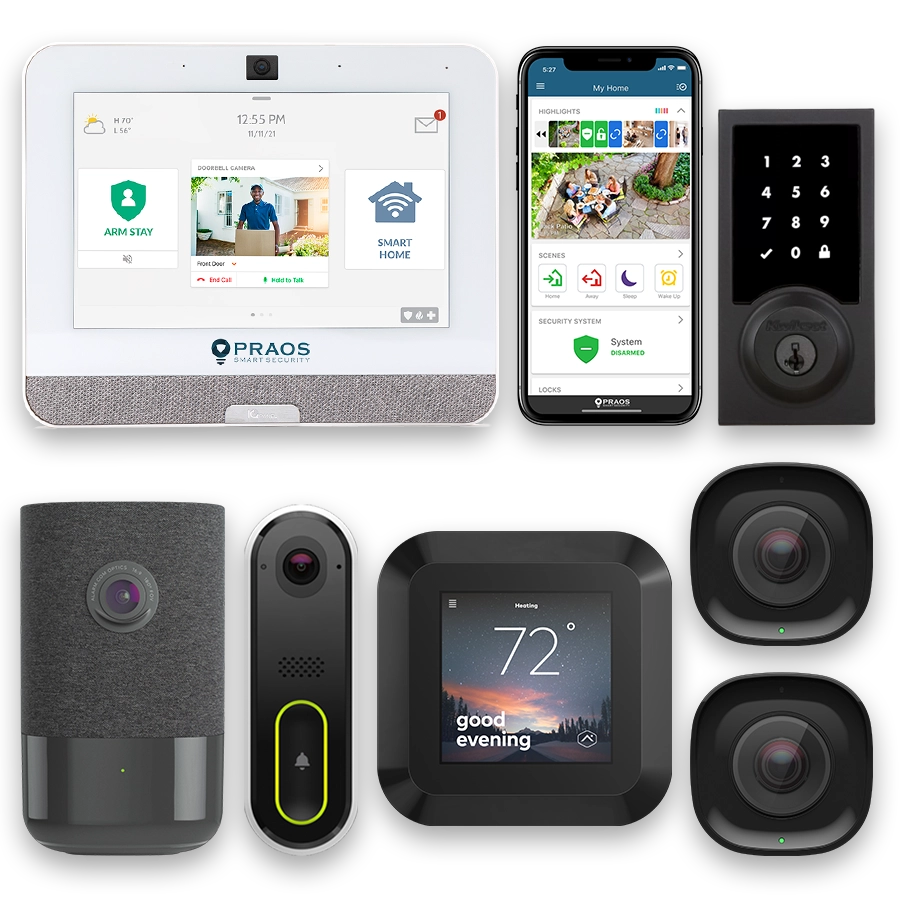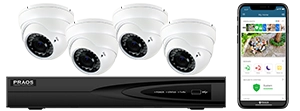The History of Home Security
The history of home security dates back to ancient times when individuals relied on manual methods to protect their homes from intruders. Early forms of home security included physical barriers such as walls, gates, and locks. These primitive methods were designed to provide a basic level of protection by making unauthorized entry difficult.
As time passed, the 18th and 19th centuries saw the advent of more sophisticated mechanisms. The invention of the mechanical lock by Robert Barron in 1778, which introduced a double-acting tumbler, marked a significant advancement. This was further improved by the pin tumbler lock invented by Linus Yale Sr. in 1848, creating a foundation for modern locking mechanisms.
The 20th century brought significant technological advancements to home security. The development of the electric alarm in 1853 by Augustus R. Pope set the stage for integrating electrical systems in home security. This device used electricity to alert homeowners of unauthorized entry through the sound of a bell.
Further innovations in the mid-20th century included the introduction of closed-circuit television (CCTV) systems in 1942. Initially used for military purposes, CCTV technology was eventually adapted for commercial and residential use. By the 1970s, these systems became more widespread in residential areas, providing visual surveillance and enhancing property security.
Throughout the late 20th century, advancements in technology continued to shape home security systems. The advent of microprocessors and digital technology in the 1980s and 1990s enabled the development of more sophisticated alarm systems, which could integrate multiple sensors and automate responses to detected threats.
Wireless technology emerged in the late 1990s and early 2000s, revolutionizing home security systems by eliminating the need for extensive wiring. This innovation allowed for easier installation and greater flexibility in placing security devices around the home.
In recent years, the proliferation of smart home technology has led to the development of integrated home security systems that can be controlled remotely via smartphones and other devices. These systems often feature advanced components such as motion detectors, door/window sensors, and high-definition cameras with night vision capabilities.
The integration of artificial intelligence (AI) and machine learning algorithms has further enhanced the capabilities of modern home security systems. Today’s systems can analyze data in real-time, identify patterns, and even predict potential security threats, making them more effective and reliable than ever before.
The Rise of Digital Surveillance
In recent years, digital surveillance has become a cornerstone of home security systems, significantly enhancing their effectiveness and accessibility. The transition from traditional analog systems to digital solutions has introduced a plethora of advanced capabilities that were previously unattainable.
One of the primary drivers behind the rise of digital surveillance is the rapid advancement in camera technology. Modern surveillance cameras now offer high-resolution imaging, often in Full HD or even 4K, allowing for clearer and more detailed video footage. This enables homeowners to monitor their properties with a level of detail that makes it easier to identify potential security threats.
Moreover, digital surveillance systems often come with features such as night vision, motion detection, and wide dynamic range (WDR) capabilities. Night vision technology leverages infrared LEDs to ensure that cameras can capture clear footage even in low-light conditions. Motion detection allows the system to trigger alerts when movement is detected within a predefined area, while WDR capabilities help manage challenging lighting conditions such as glare, shadows, and contrast, ensuring balanced and discernible images.
Another significant advancement is the integration of cloud storage solutions. Unlike analog systems, which rely on local storage media such as DVRs, digital surveillance systems often utilize cloud storage, providing several benefits:
- Scalability: Cloud storage can easily be scaled to accommodate additional footage and longer retention periods.
- Remote Access: Homeowners can access live or recorded footage from anywhere through internet-connected devices.
- Redundancy: Cloud storage provides backup options, ensuring that critical footage is not lost even if local devices are damaged or stolen.
Digital surveillance systems also frequently incorporate real-time alerts and mobile notifications, allowing homeowners to receive instant updates on their smartphones or other devices if unusual activity is detected. This immediacy enhances the ability to respond promptly to potential security breaches.
Finally, the cost and ease of installation for digital surveillance systems have improved over time, making them more accessible to a broader range of consumers. Many systems are now wireless and feature plug-and-play setup options, reducing the need for complicated wiring and professional installation.
Overall, the rise of digital surveillance has transformed home security, providing enhanced protection through advanced imaging capabilities, cloud storage, real-time alerts, and user-friendly installation and usage. These developments have laid a robust foundation for further innovations in residential safety technologies.
AI and Machine Learning in Home Security
Artificial Intelligence (AI) and Machine Learning (ML) are significantly transforming home security by providing advanced analytical capabilities and enabling predictive security measures. These technologies are being integrated into various home security systems, offering more robust and proactive solutions to keep residential areas safe.
AI in home security generally involves the utilization of algorithms that can process and analyze vast amounts of data to identify patterns and anomalies. When coupled with ML, these systems can continuously learn and improve from the data they collect, enhancing their effectiveness over time.
One major application of AI in home security is in video surveillance. Traditional cameras record continuously, often generating a large volume of footage that is seldom reviewed. AI-powered cameras, on the other hand, can differentiate between normal and unusual activities. For instance, these smart cameras can recognize familiar faces and alert homeowners or security personnel only when an unidentified person or unusual behavior is detected.
Moreover, ML algorithms enable these systems to learn and adapt to the specific habits and routines of the household, reducing false alarms caused by trivial events like pets moving around or shadows. This increases the reliability and efficiency of the surveillance system.
AI is also used in improving home alarm systems. Traditional alarms are typically triggered by motion detectors and can be prone to false alarms. AI-enhanced alarm systems can combine data from various sensors (e.g., motion, sound, heat) and use contextual analysis to accurately determine the nature of a threat. For example, breaking glass can be distinguished from other sharp noises, and the system can assess the likelihood of a break-in versus a dropped object.
Another notable capability brought by AI is predictive maintenance. Home security devices, like any technology, require maintenance, and AI can predict potential failures or necessary updates before they cause problems. By analyzing usage patterns and device conditions, AI can alert homeowners or technicians to service the system, ensuring continual optimal performance.
Here is a comparative look at traditional vs. AI-powered home security features:
| Feature | Traditional System | AI-Powered System |
|---|---|---|
| Video Surveillance | Continuous recording, high data volume | Event-triggered recording, data filtering |
| Alarm Systems | Motion detected, prone to false alarms | Contextual analysis, reduced false alarms |
| Face Recognition | Not typically available | Identifies known individuals, alerts on unknowns |
| Maintenance | Reactive | Predictive |
With the advancements in AI and ML, home security systems are becoming more intelligent, responsive, and tailored to individual needs. These innovations are not only enhancing the safety of residential properties but are also contributing to a more efficient and user-friendly security environment.
Smart Home Integration and IoT
Smart home integration and the Internet of Things (IoT) have fundamentally transformed how we approach residential safety. The continuous development of interconnected devices allows homeowners to enjoy enhanced convenience, control, and security. At the forefront of this integration is Praos, a leading home security company based in Richmond, dedicated to providing tailored solutions that fit every family’s unique needs and budget.
Praos’s dedication to home security transcends the mere installation of security systems. The company harnesses local expertise and an award-winning service record to deliver exceptional protection for your home and family. For new customers, they offer enticing incentives such as free equipment and installation when opting for a monitored new system plan.
One of Praos’s standout features is their unified home security experience, which is facilitated through a single connected app. This app seamlessly integrates security, automation, and surveillance, providing homeowners with an unparalleled level of control over multiple aspects of their smart home. From one central interface, users can monitor security cameras, control lighting, manage door locks, adjust thermostats, and more, ensuring a cohesive and streamlined user experience.
The customization of smart home systems is another hallmark of Praos’s service. Their team collaborates closely with clients to design solutions that meet specific requirements and adhere to budget constraints. This personalized approach ensures that every home security system installed by Praos offers optimum protection and efficiency.
Moreover, Praos’s monitored plans start at just $19.95 per month, making advanced home security accessible to a wider audience. This affordability does not compromise the quality of the service or the sophistication of the technology used. Praos’s clients can enjoy peace of mind knowing that their homes are under constant surveillance, regardless of their location.
Through the integration of IoT devices and smart home technology, Praos exemplifies how modern home security systems have evolved from standalone setups to comprehensive, interconnected networks. As the IoT continues to expand, companies like Praos play a crucial role in enhancing residential safety while providing convenience and peace of mind to homeowners.
Data Privacy and Ethical Considerations
The advancement of home security systems, particularly with the integration of AI and IoT, raises important data privacy and ethical considerations. These considerations encompass the collection, storage, and usage of personal data as well as the potential for misuse and surveillance.
A key concern is the volume of data that modern home security systems collect. Devices such as cameras, motion detectors, and smart locks generate extensive data including video footage, activity logs, and access records. This data, while pivotal for enhancing security, poses significant risks if not properly managed and secured.
Reports indicate that many smart home devices have vulnerabilities that could be exploited by hackers. For example, a report by Avast in 2020 found that up to 40.8% of smart homes have at least one vulnerable connected device. This highlights the importance of implementing robust security measures to safeguard against unauthorized access.
Data storage practices also come under scrutiny. Cloud storage is commonly used for storing security data, but this brings several risks. Unauthorized access to cloud servers can result in widespread data breaches, as evidenced by incidents like the Ring camera data exposure in 2019, where personal data of users was leaked. To mitigate such risks, ensuring data encryption and secure authentication protocols are essential.
Another critical ethical consideration involves surveillance and privacy. The omnipresence of cameras and sensors in residential areas can lead to privacy invasions not just for the homeowner but also for neighbors and visitors. Legal regulations like the General Data Protection Regulation (GDPR) in the EU provide frameworks for protecting individual privacy, but continuous evaluation and adaptation of these laws are necessary to keep pace with technological advancements.
The issue of data ownership is also pertinent. Homeowners must have clear rights over their collected data and transparency on how their data is used by service providers. White papers from organizations such as the Electronic Frontier Foundation (EFF) emphasize the need for users to retain control over their data to prevent misuse and exploitation.
It is also worth considering the ethical implications of AI in decision-making processes within these systems. For instance, biases in AI algorithms can potentially lead to misuse or discrimination. Ensuring that AI systems are designed and trained responsibly is crucial to avoid such outcomes. The AI Now Institute advocates for regular audits and transparent reporting to maintain fairness and accountability in AI applications.
In conclusion, while the integration of advanced systems and AI in home security offers significant benefits, it is paramount to address data privacy and ethical issues diligently. Strong security practices, regulatory compliance, user data control, and ethical AI deployment play key roles in mitigating risks and ensuring the responsible use of technology in home security.
Consumer Adoption and Market Trends
Consumer adoption of advanced home security systems has seen significant growth over the past few years. This chapter explores the factors driving this trend, examines market statistics, and highlights current consumer preferences.
Drivers of Consumer Adoption
Several factors are contributing to the widespread adoption of advanced home security systems:
- Increased Awareness: Homeowners are more aware of security threats and the available technological solutions.
- Technological Advancements: Innovations such as AI, smart devices, and cloud storage have enhanced the capabilities and appeal of modern home security systems.
- Affordability: The cost of advanced security systems has become more accessible to a broader audience.
- Remote Monitoring: The ability to monitor homes remotely through smartphones and other devices provides added convenience and peace of mind.
- Integration with Smart Home Systems: Compatibility with other smart home devices offers a cohesive and streamlined user experience.
Market Trends
The home security market is anticipated to continue growing as technology advances and consumers prioritize residential safety. According to a report by Grand View Research, the global home security systems market size was valued at USD 52.9 billion in 2022 and is expected to grow at a compound annual growth rate (CAGR) of 8.6% from 2023 to 2030.
The market can be segmented into three primary categories:
- Video Surveillance Systems: Including indoor and outdoor cameras, video doorbells, and cloud storage solutions.
- Alarm Systems: Traditional burglar alarms, motion detectors, and smart sensors.
- Access Control: Smart locks, keyless entry systems, and biometric authentication devices.
Current Consumer Preferences
A survey conducted by Parks Associates in 2021 found that the following features are most sought after in home security systems:
| Feature | Percentage of Respondents |
|---|---|
| Video Monitoring/Cameras | 67% |
| Remote Management via App | 62% |
| Intrusion Detection | 59% |
| Emergency Notifications | 54% |
| Smart Lock Integration | 45% |
These preferences reflect a growing interest in comprehensive solutions that offer both security and convenience. As technology continues to evolve, it is expected that consumer expectations will rise, pushing for even more advanced and integrated home security solutions.
Future Innovations in Home Security
The home security sector is poised for significant transformation driven by emerging technologies and innovative solutions. The following sections explore key trends and developments expected to shape the future of home security systems.
Biometric Authentication Systems
Biometric authentication, such as fingerprint scanning, facial recognition, and voice recognition, is becoming more prevalent in home security. These technologies offer higher accuracy and convenience compared to traditional locks and passwords, making them attractive to homeowners.
Advancements in biometric technology are expected to enhance system reliability and reduce false positives. Integration with other smart home devices can further streamline user experience while maintaining high security standards.
Integration of 5G Technology
The introduction of 5G networks will significantly influence the functionality and effectiveness of home security systems. Enhanced bandwidth and reduced latency will enable faster data transmission, improving real-time monitoring and response capabilities.
5G will also facilitate the seamless integration of multiple smart home devices, allowing for a more coordinated and responsive security ecosystem. This promising technology is anticipated to revolutionize connectivity and operational efficiency in residential security.
Cloud-Based Solutions
Cloud computing will continue to play a critical role in the future of home security. Cloud-based systems offer numerous benefits such as remote access, data storage, and centralized control. These advantages are crucial for managing complex security environments and ensuring continuous operation.
With ongoing improvements in cloud technologies, future home security systems will likely include more sophisticated features such as predictive analytics and automated threat responses based on historical data.
Use of Artificial Intelligence and Machine Learning
AI and machine learning will become even more integral to home security systems, enhancing capabilities in areas such as threat detection, behavior analysis, and predictive maintenance. AI-powered cameras and sensors can recognize unusual activities and alert homeowners or authorities promptly.
Machine learning algorithms will improve over time as they process more data, leading to greater accuracy and fewer false alarms. The combination of AI and machine learning promises to deliver more proactive and intelligent security solutions.
Robotic Security Systems
Robotic security systems are another frontier in home security innovation. These robots can patrol properties, monitor for intrusions, and interact with other smart home devices. Equipped with cameras, sensors, and sometimes even weapons, they provide an active deterrent to potential threats.
As robotics technology advances, these systems are expected to become more versatile and affordable, making them accessible to a wider range of homeowners.
Enhanced Cybersecurity Measures
With the increasing digitization of home security, cybersecurity becomes paramount. Future innovations will likely include reinforced encryption methods, advanced firewalls, and continuous security updates to protect systems from cyberattacks.
Manufacturers are expected to place greater emphasis on comprehensive security protocols to safeguard sensitive data and ensure system integrity.
Table: Key Future Innovations in Home Security
| Innovation | Expected Impact |
|---|---|
| Biometric Authentication | Enhanced security through accurate and convenient authentication methods. |
| 5G Technology | Improved connectivity and real-time monitoring capabilities. |
| Cloud-Based Solutions | Centralized control and upgraded features leveraging cloud computing. |
| AI and Machine Learning | Proactive threat detection and intelligent analysis. |
| Robotic Security Systems | Active property monitoring and intrusion deterrence. |
| Enhanced Cybersecurity | Increased protection against digital threats. |
The advancements outlined reflect a future where home security is more integrated, intelligent, and responsive. While challenges remain, such as ensuring user privacy and managing costs, the potential benefits of these innovations are substantial. Homeowners can expect more robust protections and a higher quality of life as these technologies continue to evolve.
Case Studies of Advanced Systems in Use
In examining advanced home security systems currently in use, it’s crucial to highlight several real-world examples that have benefitted from innovative technologies such as AI, IoT, and machine learning. These case studies provide insight into how modern advancements have enhanced residential safety beyond traditional measures.
ADT and Google Nest Partnership
In 2020, ADT, a leading security provider, partnered with Google Nest to integrate smart home technologies into their security offerings. The collaboration allows ADT customers to leverage Google Nest’s advanced cameras, thermostats, and smart displays, enhancing the overall security environment of their homes.
Key benefits include:
- Real-time alerts: The system can send immediate notifications to homeowners and emergency responders.
- AI-driven analytics: Advanced algorithms analyze video feeds to distinguish between potential threats and benign activities, reducing false alarms.
- Improved user experience: Integration with Google Home allows for seamless voice control and automation.
Ring’s Comprehensive Security Suite
Ring, a subsidiary of Amazon, has developed a robust security platform that combines video doorbells, security cameras, and alarms into an interconnected system. Known for its user-friendly app and reliable hardware, Ring has expanded its market to include integrated security solutions that safeguard residential properties effectively.
Key features of Ring’s security suite involve:
- Cloud video storage: Footage is stored securely online, ensuring that important video evidence is preserved.
- Neighborhood engagement: The Ring Neighbors app facilitates community vigilance by allowing users to share alerts and updates about local security concerns.
- Artificial Intelligence: AI is employed to enhance motion detection, optimize alert accuracy, and provide users with intelligent notifications.
SimpliSafe’s DIY Security Solutions
SimpliSafe has become prominent in the home security sector thanks to its do-it-yourself installation approach and affordable pricing. The company’s products include wireless security systems that are easy to adapt and expand according to user needs.
Highlighting key advantages:
- Customizability: Users can tailor their security setup with various sensors, cameras, and monitoring services.
- 24/7 monitoring: Professional monitoring options ensure that any alerts or breaches are handled promptly by security experts.
- Smart home compatibility: SimpliSafe systems can be integrated with smart home devices, allowing for comprehensive home automation and control.
Vivint’s Integrated Smart Home Ecosystem
Vivint stands out with its focus on fully integrated smart home ecosystems. The company offers a range of services that link security systems with other smart home devices, such as thermostats, lights, and garage door openers.
Notable features include:
- Smart analytics: Vivint uses AI to learn the homeowner’s habits and adjust settings for efficiency and safety.
- Professional installation: Ensures that the system is set up optimally for maximum security and convenience.
- Emergencies and alerts: Immediate notifications and direct connection to emergency services provide enhanced response times in critical situations.
In conclusion, these case studies underscore the significant strides made in home security through advanced technology. By leveraging AI, machine learning, and the Internet of Things, modern security systems offer enhanced protection, improved user experiences, and a higher level of adaptability to individual home environments.






